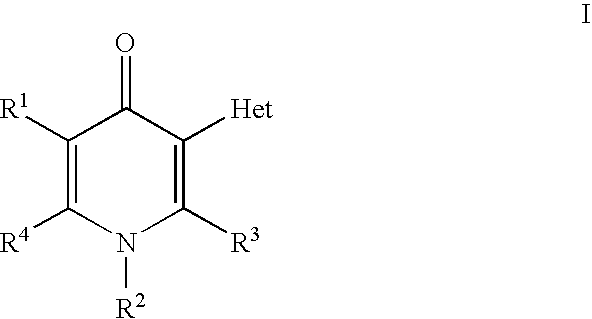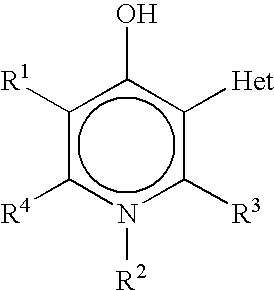Pyridinone derivatives against malaria
a technology of pyridinone and derivatives, which is applied in the field of pyridinone derivatives and 4pyridone, can solve the problems of parasite resistance to available drugs, large economic loss in animal husbandry,
- Summary
- Abstract
- Description
- Claims
- Application Information
AI Technical Summary
Benefits of technology
Problems solved by technology
Method used
Image
Examples
example 1
[0433]
5-Bromo-2,6-dimethyl-6′-{[4-(trifluoromethoxy)benzyl]oxy}-3,3′-bipyridin-4(1H)-one
[0434]To a solution of Intermediate 27 (0.211 g) in a mixture dichloromethane / methanol v / v 2:1 (30 ml) was added portionwise N-bromosuccinimide (0.106 g). The mixture was stirred at room temperature under inert atmosphere for 1 h. Removal of the solvent under vacuum gave a crude white powder which was triturated with acetonitrile (20 ml) and filtered. The solid obtained was washed with acetonitrile, then dried under vacuum to afford 0.217 g of the title compound as a white powder.
[0435]1H-NMR (δ, ppm, DMSO-d6): 11.15 (bs, 1H); 7.97 (bd, 1H); 7.62-7.55 (m, 3H); 7.37 (d, 2H); 6.90 (d, 1H); 5.39 (s, 2H); 2.41 (s, 3H); 2.1 (s, 3H); [ES MS] m / z 470 (MH+)
[0436]Examples 2-7 were prepared by methods analogous to that described for Example 1 replacing Intermediate 27 with the Intermediate shown in Table 9.
[0437]
TABLE 9StartingEx.RIntermediateChemical namePhysical Data23-CF3285-Bromo-2,6-dimethyl-6′-{[3-1H...
example 8
[0438]
5-Chloro-2,6-dimethyl-6′-{[4-(trifluoromethoxy)benzyl]oxy}-3,3′-bipyridin-4(1H)-one
[0439]To a cooled solution (0-4° C., ice / water bath) of Intermediate 27 (0.276 g) in a mixture dichloromethane / methanol v / v 2:1 (24 ml) was added portionwise under inert atmosphere trichloroisocyanuric acid (ALDRICH, 67 mg). The mixture was stirred at low temperature under inert atmosphere for 1.5 h, then diluted with a mixture dichloromethane / methanol v / v 2:1 (30 ml) and the cyanuric acid precipitated filtered. The filtrate was concentrated to dryness under vacuum to afford a solid residue which was suspended in a mixture of aqueous 0.5N NaOH (30 ml) and methanol (10 ml). After stirring for 1 h, the mixture was diluted by adding water (20 ml) and the remaining precipitate was filtered and washed successively with water (3×10 ml), mixture methanol / water v / v 1:1 (2×10 ml) and acetonitrile (3×10 ml). 0.193 g of the title compound were obtained as a white powder after drying under vacuum.
[0440]1H-N...
example 15
[0443]
5-Bromo-2,6-dimethyl-6′-{4-[(trifluoromethyl)oxy]phenyl}-3,3′-bipyridin-4(1H)-one
[0444]To a solution of Intermediate 34 (0.064 g) in a mixture of dichloromethane / methanol v / v 1:1 (2 ml) was added portionwise at room temperature N-bromosuccinimide (0.026 g). The suspension was stirred at room temperature for 30 min, then concentrated to dryness under vacuum. The residue thus obtained was triturated with ethyl acetate and filtered. The solid was washed with ethyl acetate and dried under vacuum. 0.062 g of the title compound were obtained as a white powder.
[0445]1H-NMR (δ, ppm, DMSO-d6): 11.7-11.6 (bs, 1H); 8.49 (m, 1H); 8.27-8.22 (m, 2H); 8.03 (d, 1H); 7.75 (dd, 1H); 7.48 (m, 2H); 2.44 (s, 3H); 2.15 (s, 3H); [ES MS] m / z 439 (MH+)
[0446]Examples 16-26 were prepared by methods analogous to that described for Example 15, replacing Intermediate 34 with the Intermediate indicated in Table 11.
[0447]
TABLE 11StartingEx.RIntermediateChemical namePhysical Data164-CF3375-Bromo-2,6-dimethyl-...
PUM
 Login to View More
Login to View More Abstract
Description
Claims
Application Information
 Login to View More
Login to View More - R&D
- Intellectual Property
- Life Sciences
- Materials
- Tech Scout
- Unparalleled Data Quality
- Higher Quality Content
- 60% Fewer Hallucinations
Browse by: Latest US Patents, China's latest patents, Technical Efficacy Thesaurus, Application Domain, Technology Topic, Popular Technical Reports.
© 2025 PatSnap. All rights reserved.Legal|Privacy policy|Modern Slavery Act Transparency Statement|Sitemap|About US| Contact US: help@patsnap.com



